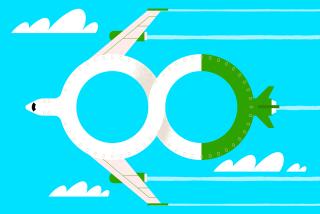Just a Hop, Skip and Bump Away From Missing a Flight
- Share via
The U.S. Transportation Department, never known for coining zippy nicknames, calls them passengers denied boarding. But we know them as bumpees. Some travelers strive to be bumped, yearning for the perks that airlines offer those who are cast off from flights. But others--about 4,800 every month--have “bumpee” status thrust upon them. Sometimes it’s not pretty.
Over the last few years, as travel has boomed and this country’s largest airlines have found themselves with fuller and fuller flights, the risk (or hope) of being bumped has seemed to loom larger and larger. Noting that, budget-travel guru Tom Parsons in November treated readers of his Best Fares magazine to several tips on the inexact art of getting bumped on purpose, in order to gain perks for future flights. (Back to that in a moment.)
In fact, your odds of being bumped these days are higher than they were in 1992, when the airlines were losing billions and desperate to fill their seats. But, whatever corporate sins consumers may hold the airlines responsible for, the fact is that the same sophisticated computer number-crunching that helps airlines juggle prices so confoundedly, also has permitted the carriers to allow only modest increases in the number of oversold flights.
As in years past, many consumers continue to reserve seats and not use them--especially business travelers who may book seats on the 1 p.m., 2 p.m. and 3 p.m. departures of an LAX-San Francisco shuttle flight, just to keep their options open. If you’re flying on expensive unrestricted tickets, as many business travelers do, there’s no penalty for failing to show. Hence, says an American Airlines spokesman, no-show rates of 10% to 15% are common. But the airlines’ “yield management” formulas now allow them to predict no-shows with such accuracy that in the first nine months of last year, Transportation Department records show that just 1.16 per 10,000 passengers on major carriers were involuntarily bumped.
By comparison, the figure was 0.92 in 1992, 1.00 in 1993, 1.16 in 1994, 1.06 in 1995, and 1.20 in 1996. The change has been more dramatic for voluntary bumps, which happened nearly 20 times as often as involuntary ones last year. In the first nine months of 1997, your odds of getting voluntarily bumped were about one in 485. Back in 1993, the figure was about one in 700.
Southwest Airlines, long lauded for its efficiency and pleasant service, has for years ranked among the major airlines most likely to throw passengers off involuntarily. (However, because of Southwest’s high-frequency scheduling, there’s often another flight in an hour.)
Over the first nine months of last year, Continental Airlines logged the lowest rate of involuntary bumps among major carriers--just 0.11 per 10,000 passengers boarded. Runners-up were United (0.50), Northwest (0.61), American (0.72), US Airways (0.96) and Delta (1.69). Bringing up the rear: America West (2.10), Southwest (2.36) and Alaska (2.55).
Who decides what you get for being bumped? If it’s involuntary, airlines follow federal rules: Generally, you get nothing if your arrival is delayed less than an hour. If you’re delayed one to two hours on a domestic flight (or one to four hours on an international flight), the airline is required to pay you 100% of the cost of the disrupted flight segment, up to $200. If the bumping causes a delay of more than two hours on a domestic flight or four hours on an international flight, the mandated amount is 200%, up to $400. If you’re bumped voluntarily, there are no federal rules in effect, and the airline decides what it wants to offer. On flights with fewer than 61 seats, no bump compensation is required.
For most travelers, the question at the bottom of these rules and statistics is how to avoid being bumped. Check in early at the gate, especially in cases when the plane is expected to be heavily booked. (If you check in less than 20 minutes ahead of your scheduled departure time, the airline generally is free to bump you and give no compensation.)
Remember that the airlines are always required to ask for volunteers before they start bumping people involuntarily. If you find yourself being bumped and don’t remember hearing a call for volunteers, raise that issue.
But perhaps you have a little travel time to spare, and you could use a few dollars or a ticket. Then your question may be, How can I get bumped?
Consider Tom Parsons, budget travel guru and reader of fine print. Parsons reports that he was happily bumped at least 11 times in 1997, “and every time I walked away with a free round-trip ticket (sometimes for first-class travel), a free phone call and a free meal.” Whenever a bumpee faces a delay of more than two hours, Parsons suggests asking for a long-distance call (or calling card), a meal ticket, admission to the airport club, and in-flight coupons for a headset.
His strategy for getting left behind: Check in early (about 90 minutes ahead of departure time), ask if the flight is oversold, and if they’ll be seeking bump volunteers. And hope it’s a hot day.
Higher temperatures, Parson explains, give planes less lift on takeoff, which sometimes force carriers to limit total passenger weight. You could find yourself bumped from a flight even though it has empty seats.
Reynolds travels anonymously at the newspaper’s expense, accepting no special discounts or subsidized trips. He welcomes comments and suggestions, but cannot respond individually to letters and calls. Write Travel Insider, Los Angeles Times, Times Mirror Square, Los Angeles 90053 or e-mail chris.reynolds@latimes.com.
More to Read
Sign up for The Wild
We’ll help you find the best places to hike, bike and run, as well as the perfect silent spots for meditation and yoga.
You may occasionally receive promotional content from the Los Angeles Times.







